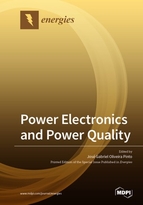Power Electronics and Power Quality
A special issue of Energies (ISSN 1996-1073).
Deadline for manuscript submissions: closed (28 February 2018) | Viewed by 96266
Special Issue Editor
Interests: power electronics; power quality; active power conditioners; renewable energy systems; electric vehicles; digital control of power electronics converters
Special Issues, Collections and Topics in MDPI journals
Special Issue Information
Dear Colleagues,
The first studies on power quality were published in the sixties of the last century; however, the evolution of electric power systems, and especially the advances in power electronics, highlighted the significance of this matter in modern power systems. Nowadays, power systems are experiencing new challenges: the decentralized generation, the integration of renewable energy systems, the widespread of plug-in electric and hybrid-electric vehicles, the electrification of railway systems, the distributed control in smart grids, and the interconnected or islanded operation of microgrids brings to a higher level the importance of power quality. This scenario stimulates the research and development in monitoring technologies and power electronics solutions to ensure the power quality of the future power systems. This Special Issue of Energies intends to collect and disseminate the latest research and developments related to “Power Electronics and Power Quality”. The topics of interest include, but are not limited to:
- advanced power quality monitoring (smart meters, advanced metering infrastructure, phasor measurement unit, signal processing technics, event classification)
- active power conditioners (active power filters, hybrid filters, unified power quality conditioners (UPQCs))
- control techniques for power quality improvement (power theories, signal processing technics, artificial neural networks)
- power quality in smart grids and microgrids (islanding detection, grid synchronization, voltage control, frequency control)
- energy storage systems with power quality ancillary services (energy storage technologies, voltage support, reactive power control, active damping control)
- electric vehicle battery chargers with smart operation modes (grid-to-vehicle, vehicle-to-grid, vehicle-to-home, home-to-vehicle)
- integration of renewable energy systems with power quality ancillary services (voltage control, harmonics compensation)
Dr. José Gabriel Oliveira Pinto
Guest Editor
Manuscript Submission Information
Manuscripts should be submitted online at www.mdpi.com by registering and logging in to this website. Once you are registered, click here to go to the submission form. Manuscripts can be submitted until the deadline. All submissions that pass pre-check are peer-reviewed. Accepted papers will be published continuously in the journal (as soon as accepted) and will be listed together on the special issue website. Research articles, review articles as well as short communications are invited. For planned papers, a title and short abstract (about 100 words) can be sent to the Editorial Office for announcement on this website.
Submitted manuscripts should not have been published previously, nor be under consideration for publication elsewhere (except conference proceedings papers). All manuscripts are thoroughly refereed through a single-blind peer-review process. A guide for authors and other relevant information for submission of manuscripts is available on the Instructions for Authors page. Energies is an international peer-reviewed open access semimonthly journal published by MDPI.
Please visit the Instructions for Authors page before submitting a manuscript. The Article Processing Charge (APC) for publication in this open access journal is 2600 CHF (Swiss Francs). Submitted papers should be well formatted and use good English. Authors may use MDPI's English editing service prior to publication or during author revisions.
Keywords
- power electronics
- power quality
- power quality monitoring
- power quality mitigation
- power quality conditioners
- control theories
- smart grids
- microgrids
- energy storage systems
- distributed generation
- renewable energy systems
- electric vehicles
Related Special Issues
- Power Electronics and Power Quality 2023 in Energies (1 article)
- Power Electronics and Power Quality 2021 in Energies (4 articles)
- Power Electronics and Power Quality 2019 in Energies (11 articles)






